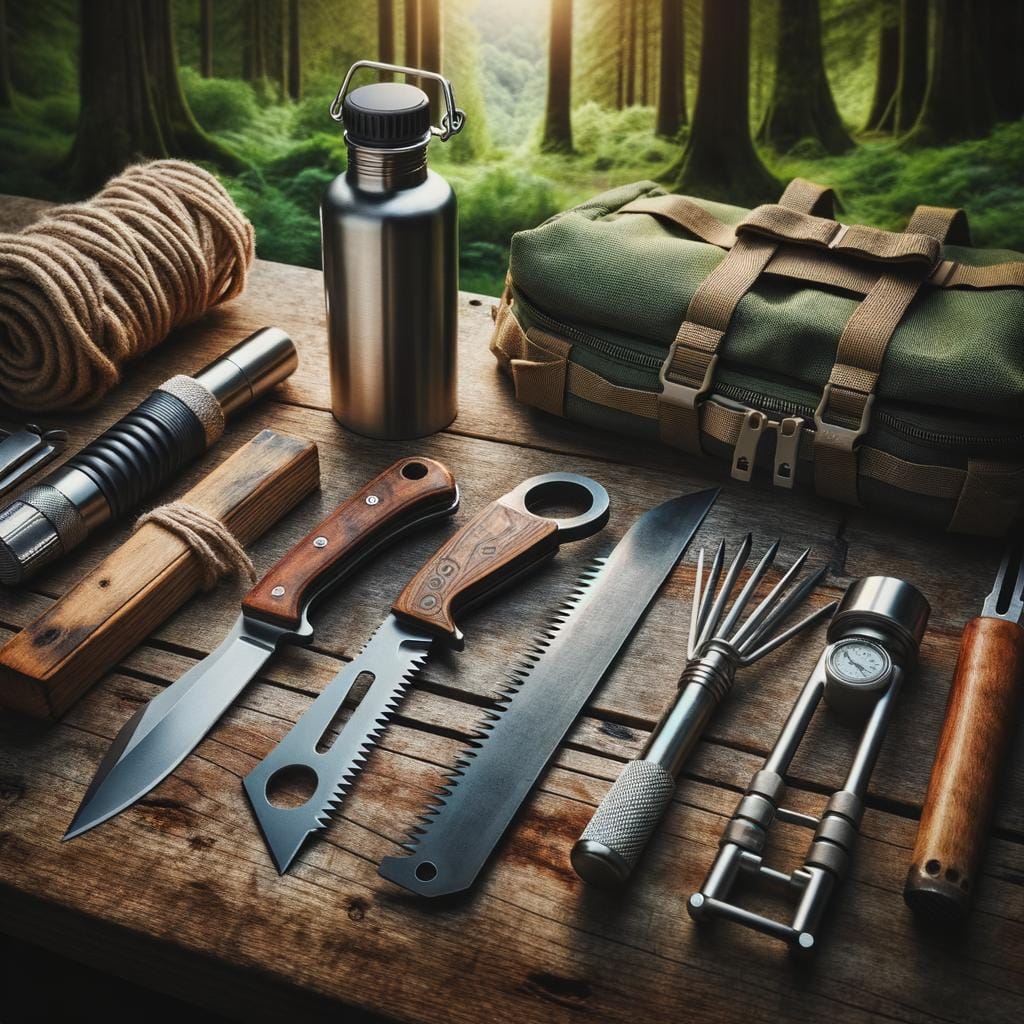Bushcraft, an essential skill for outdoor enthusiasts, encompasses a range of techniques and knowledge focused on thriving in the wilderness. Rooted in ancient traditions and survival practices, bushcraft equips individuals with the ability to live off the land using minimal tools and resources. From building shelters to finding food and purifying water, bushcraft is about self-reliance and connection to nature.
The history of bushcraft can be traced back to primitive cultures where survival skills were crucial for daily existence. Over time, these skills have evolved and adapted to modern-day scenarios, making bushcraft a valuable skill set for adventurers, campers, hikers, and preppers alike. By understanding the fundamental principles of bushcraft, individuals can enhance their wilderness experiences while also being prepared for unexpected situations.
In this comprehensive guide to bushcraft, we will delve into the essential skills needed for survival in the wild, the tools and gear required for bushcraft activities, techniques for building shelters using natural materials, methods for locating and purifying water sources, tips on foraging for food in nature, navigating through the wilderness with confidence, and addressing safety concerns while practicing bushcraft activities.
Whether you are a beginner or seasoned outdoorsman, mastering the art of bushcraft can not only enhance your outdoor adventures but also foster a deeper appreciation for the natural world.
Essential Skills in Bushcraft
Bushcraft is not just a hobby, it is a way of life that focuses on utilizing skills and knowledge to thrive in the wilderness. To truly excel in bushcraft, one must possess essential survival skills that are crucial for navigating and surviving in the wild. These skills not only ensure one’s safety but also increase their chances of successfully overcoming any challenges encountered in the great outdoors.
Here are some key basic survival skills that every bushcrafter should master:
- Fire Making: Being able to start a fire without matches or a lighter is essential in bushcraft. Knowing how to build different types of fire lays and using natural tinder materials can make all the difference in staying warm, cooking food, and signaling for help.
- Shelter Building: Creating a shelter is vital for protection against the elements. Whether it’s constructing a debris hut, lean-to shelter, or tarp shelter, understanding how to utilize natural materials to build a sturdy structure is crucial for survival.
- Wilderness First Aid: Accidents can happen anytime, especially in rugged environments. Having knowledge of basic first aid techniques like treating cuts, burns, fractures, and bites can prevent minor injuries from escalating into serious situations.
In addition to these skills, mastering navigation with map and compass or using natural clues such as sun position and tracking animal trails can help you find your way through unknown terrains. It’s important to continuously practice and hone these essential skills to become proficient in bushcraft and truly experience the beauty of living harmoniously with nature. Remember, proper preparation and knowledge are key to enjoying safe and rewarding adventures in the wilderness.
Bushcraft Tools and Gear
When venturing into the wilderness to practice bushcraft, it is essential to have the right tools and gear to ensure your safety and success. Whether you are a novice or an experienced outdoorsman, having the proper equipment can make a significant difference in your bushcraft experience. Here are some essential tools and gear that every bushcraft practitioner should have:
- Knife: A sturdy and sharp knife is one of the most important tools in bushcraft. It can be used for cutting wood, preparing food, making shelters, and various other tasks.
- Fire Starter: In bushcraft, fire is crucial for warmth, cooking, signaling for help, and morale. Carrying a reliable fire starter such as waterproof matches, lighters, or ferro rods is essential.
- Cordage: Having strong cordage like paracord or natural fibers can be useful for building shelters, creating traps, securing gear, and many other purposes.
Having the right tools is crucial in bushcraft activities not only for practical reasons but also for safety considerations. When choosing your gear, opt for high-quality items that are durable and reliable. Being prepared with the necessary tools will not only enhance your experience in the wild but also increase your chances of successfully practicing bushcraft techniques.
Remember that proper maintenance of your tools and gear is equally important. Regularly check and sharpen your knife, replace any worn out cordage or fire starters, and ensure that all equipment is in good working condition before heading out into the wilderness for your next bushcraft adventure. By being well-equipped with the right tools and gear, you can fully immerse yourself in the world of bushcraft with confidence.
Building Shelter in the Wild
When engaging in bushcraft activities, one of the essential skills to master is building shelters using natural materials found in the wilderness. These shelters provide protection from the elements, helping to keep you warm and dry during your outdoor adventures. There are various techniques that can be employed depending on the environment and available resources.
One common method for building a shelter in the wild is constructing a debris hut. This simple yet effective shelter involves creating a framework using branches and then layering leaves, grass, and other natural debris to form a waterproof covering. Debris huts are quick to build and provide adequate insulation, making them ideal for short-term survival situations.
Another technique for shelter construction is building a lean-to shelter. This type of shelter consists of a slanted roof supported by one side with the other open, facing away from the wind.
By using logs or branches as support beams and covering them with leaves or bark, a basic lean-to can be quickly assembled. It is important to ensure that the roof angle is sufficient to shed water effectively and that the opening is facing away from prevailing winds for optimal protection.
| Shelter Type | Advantages |
|---|---|
| Debris Hut | Quick to build, provides good insulation |
| Lean-To Shelter | Easy assembly, effective wind protection |
Finding and Purifying Water
One method for finding water in the wild is to look for signs such as animal tracks, lush vegetation, or low-lying areas where water may collect. Streams, rivers, lakes, and even dew on leaves can be potential sources of water that can be purified for consumption. It is important to remember that not all water sources are safe to drink without proper treatment.
In order to make water safe for drinking, there are several purification methods that can be employed in bushcraft. Boiling water is a simple and effective way to kill bacteria and parasites that may be present. Another method is using purification tablets or filters to remove impurities from the water. Additionally, natural methods like solar stills or using charcoal can also help purify water in emergency situations.
| Water Source | Purification Method |
|---|---|
| River/stream | Boiling |
| Lake/pond | Purification tablets/filter |
| Dew on leaves | Solar stills/charcoal filtration |
Foraging for Food
Identifying Edible Plants
One of the first steps in foraging for food is learning how to identify edible plants. It is important to be able to differentiate between edible plants and potentially toxic ones, as consuming the wrong plant can have severe consequences.
There are various guidebooks, online resources, and even hands-on courses available that can help individuals learn how to recognize safe edible plants in their area. It is also advisable to start with easily recognizable plants such as dandelions, wild berries, and clover before moving on to more advanced foraging.
Gathering Wild Food Sources
Once you have identified edible plants in the wild, it is crucial to know how to gather them safely and responsibly. When harvesting wild food sources, it is essential to only take what you need while ensuring that you do not deplete the plant population.
Some best practices include not harvesting near roadsides or contaminated areas where pollution may be present, picking from different locations to avoid over-harvesting, and respecting wildlife habitats when foraging. Additionally, understanding when certain plants are in season can help ensure a successful foraging experience.
Navigation in the Wilderness
Navigating in the wilderness is an essential skill in bushcraft, requiring knowledge of basic orienteering techniques and the ability to interpret natural clues to find your way. Whether you’re exploring a dense forest or traversing open terrain, understanding how to navigate without relying on modern technology is crucial for a successful bushcraft experience.
Orienteering Techniques
One of the fundamental skills in bushcraft navigation is the use of a map and compass. Learning how to read a topographic map, identify key landmarks, and calculate distances using a compass are essential for navigating with accuracy. In addition to traditional tools, mastering techniques such as triangulation and dead reckoning can help you stay on course even in challenging environments.
Using Natural Clues
In bushcraft, nature provides numerous clues that can help guide you in the right direction. Paying attention to the position of the sun, wind patterns, and natural features like rock formations or animal trails can give you valuable information about your surroundings. By honing your observation skills and understanding how to interpret these signs, you can navigate more effectively without relying solely on traditional methods.
Practical Tips
When venturing into the wilderness, always have a backup plan in case you get lost. Leave trip plans with someone responsible before heading out, carry a whistle or signaling device for emergencies, and familiarize yourself with local wildlife and potential hazards.
Stay calm if you find yourself disoriented and remember that staying put may be safer than wandering aimlessly. By combining practical knowledge with a respect for nature’s guidance, you can enhance your navigation skills in bushcraft while enjoying a deeper connection to the outdoor environment around you.
Safety in Bushcraft
In conclusion, it is essential to prioritize safety when engaging in bushcraft activities. While bushcraft can be a rewarding experience that connects individuals with nature and fosters self-reliance, it also comes with potential hazards that must be addressed. By understanding the risks involved and taking necessary precautions, enthusiasts can ensure a safe and enjoyable wilderness experience.
One of the key aspects of safety in bushcraft is proper preparation. This includes informing someone of your plans before heading out into the wild, carrying essential survival gear such as a first aid kit, signaling devices, and navigation tools, as well as researching the area you will be exploring. Being equipped with the knowledge and resources to handle emergencies can make all the difference in a potentially dangerous situation.
Moreover, practicing situational awareness and making sound decisions while in the bush is crucial for minimizing risks. It is important to constantly assess your surroundings, weather conditions, and personal fatigue levels to avoid accidents or getting lost. By staying alert and adapting to changing circumstances, bushcraft enthusiasts can mitigate potential dangers and fully enjoy their outdoor adventures in a safe manner. Remember, safety should always be the top priority when venturing into the wilderness to practice bushcraft skills.
Frequently Asked Questions
What Is the Meaning of Bushcraft?
Bushcraft refers to a set of skills and knowledge related to surviving and thriving in the natural environment. It involves using resources from nature to create shelter, find food and water, make tools, and navigate without modern conveniences.
Is Bushcraft Legal in the US?
In the US, practicing bushcraft is legal on public lands as long as it doesn’t violate any specific regulations or restrictions in place. It is essential to obtain necessary permits if required for camping, hunting, fishing, or gathering materials on public lands.
What Is a Bushcraft in Camping?
Bushcraft in camping involves using traditional wilderness survival skills to enhance the camping experience. This can include building shelters from natural materials, starting fires without matches or lighters, purifying water from natural sources, and identifying edible plants for foraging. These skills add a sense of self-reliance and connection to nature while camping.

An avid outdoor enthusiast, writer, and environmental advocate who has spent over two decades exploring the world’s most breathtaking landscapes. With a background in environmental science and a passion for adventure, Frances combines her love for nature with her talent for storytelling to inspire others to embark on their own outdoor journeys.



